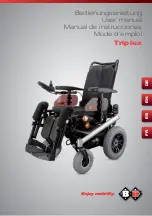
Maintenance
4
Maintenance
4.1
Safety information
Regular checks and maintenance of the wheelchair ensure the user’s
safety and the expected lifetime of the chair.
4.2
Maintenance electrical version — SM
General
The electrical products are closed units and require no
internal maintenance.
CAUTION!
Risk of damage to the product
–
The plastic parts in the system cannot tolerate cutting
oil.
–
Do not use chemicals, inspect the system yearly for
damage and wear.
–
Do not use strong solvents, basic or alkaline liquids.
–
The system must be cleaned at regular intervals to
remove dust and dirt.
–
The system must be inspected at regular intervals for
mechanical damages, wear and breaks.
–
The system must be inspected at attachment points,
wires, piston rods, cabinets and plugs.
Battery
The electrical products are closed units and require no
internal maintenance.
CAUTION!
Risk of damage to the product
–
Handle the battery carefully.
–
The battery should be replaced after 4 years at the
latest depending on the usage frequency.
–
For an optimum lifetime, the product must be
connected to the mains voltage as often as possible.
It is recommended to load the battery at least every
3:rd month.
–
Test the battery function at least once a year.
4.3
Flat tire
If you have a flat tire on your wheelchair, contact your
Invacare dealer in order to get the flat tire attended to by
competent personnel.
4.4
Cleaning
•
Wipe metal parts and the upholstery regularly with a damp cloth.
•
A mild detergent may be used.
•
If necessary, the upholstery can be washed at 60º C.
•
Normal washing powder/liquid may be used.
Only use water and soft soap to clean the table!
•
For disinfection only use alcohol based detergent.
4.5
Washing and disinfection
1.
Remove all loose and removable covers and wash them in a
washing machine according to the washing instructions for each
cover.
2.
Remove all padded parts such as seat cushions, armrests,
headrest/neckrest with fixed padded parts, calf pads and so on
and clean them separately.
The padded parts can not be cleaned with a high-pressure
cleaner or water jet.
3.
Spray the wheelchair chassis with detergent, for example a
car-cleaning agent with wax, and leave on to work.
4.
Rinse the wheelchair chassis with a high-pressure cleaning or
ordinary jet of water depending on how dirty the wheelchair is.
Do not aim the jet towards bearings and draining holes. If the
wheelchair chassis is washed in a machine the water must not be
hotter than 60º C.
5.
Spray the wheelchair chassis with alcohol for disinfection.
Only use water and soft soap to clean the table!
6.
Leave the wheelchair to dry in a drying cabinet. Remove parts
where water has collected for example in end tubes, ferrules etc.
If the wheelchair has been washed in a machine, blow-drying with
compressed air is recommended.
Dartex®
Lighter stains on the fabric may be neutralized with a soft damp cloth
and some neutral detergent. To neutralize larger, more persistent
stains, wipe the fabric with alcohol or turpentine substitutes, and
wash with hot water and a neutral detergent.
Proprietary disinfectants may be used, provided that the
manufacturer’s instructions are followed. The fabric can be washed at
temperatures up to 71º C (160º F). Normal detergents can be used.
All parts of the wheelchair with Dartex® upholstery, such as
armrest pads, calf pads, headrest/neckrest, should be cleaned
according to the instruction above.
4.5.1
Electrical version
Important!
–
The Azalea with electrical backrest or tilt is protected
according to IPX6. This means that the product can
be washed with a brush and water. The water can be
under pressure (garden hose or equivalent), but high
pressure water must not be sprayed directly towards
the electrical system.
–
Max washing temperature 20º C.
–
Do not use a steam cleaner.
–
Before cleaning, make sure that the power plug is not
connected.
–
Interconnected cables must remain plugged in when
cleaning the product.
–
Retract the actuator to the innermost position when
cleaning to avoid degreasing of the piston rod.
1580313-B
27














































